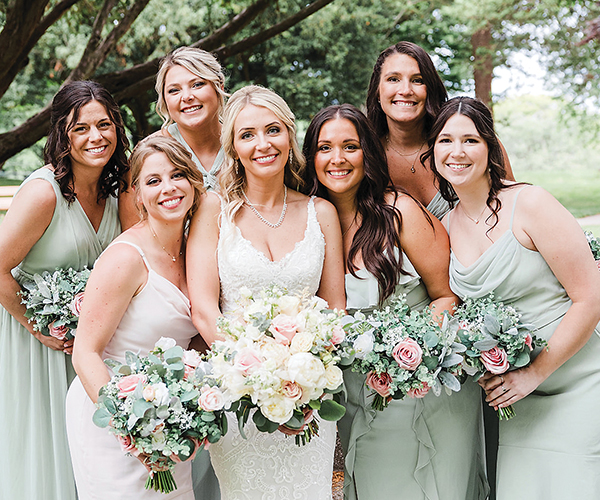Chef's Garden
by Kristen Hampshire | Jan. 28, 2008 | 5:00 AM
You don’t need an acre of land or a whole lot of experience to grow herbs successfully. They are low maintenance and offer a rewarding bounty. Some produce attractive flowers that add interest to a landscape bed, others make nice container plants that winter indoors.
“If you have a windowsill with a bit of sun, that’s all you need,” says Loretta Paganini, founder of the Loretta Paganini School of Cooking in Chesterland.
Annual herbs must be replanted each year. They will grow, produce edible foliage for a time (depending on the herb variety) and die at season’s end. You must dig up the plant and amend the soil the following spring when it’s time to start over. Basil, parsley and garlic are annuals.
Perennials wake up in the spring, grow and flourish during peak season, and go to sleep in late fall through the winter. If you maintain them by deadheading and fertilizing every few years, they will provide you with fresh herbs for years to come, McCulloh says. Oregano, sage, thyme and fennel are perennials.
Herbs are accustomed to a Mediterranean climate — arid temperatures and dry, rocky soils. Plants such as rosemary and bay leaf will thrive year round if you bring them indoors in late fall. “They don’t like the winters here,” McCulloh says.
Keep rosemary in a sunny window away from heat registers that will stress the plant. “Rosemary likes a cool, bright situation, even a sun porch,” McCulloh suggests.
Starting out
They crave sunshine, so if you plan to keep them indoors, set them in a window where full sun will drench them each day. Outdoors, container plantings are a convenient vessel for growing herbs, which require adequate drainage. Or nestle herb plants in beds with flowers.
“Use your imagination and find out when the herbs will be flowering and when they will be useful,” suggests Rich Kanary, president of Kanary’s Landscaping in Sheffield.
Sage produces spikes of blue-lavender flowers. Fennel grows up to 3 feet tall and pops yellow, flat-topped flowers. “They blend well in a bed with showier flowers,” McCulloh says. Adding garlic bulbs to rose beds is said to repel pests, she adds.
As for basic planting tips, begin by preparing soil. Churn up existing soil in garden beds and mix in compost. Containers require potting soil and a pot with a hole in the bottom for proper drainage.
Plant in threes, McCulloh advises. That way, your bounty will be sufficient for your cooking needs. “Designers always say plant in odd numbers because it looks less awkward,” she adds.
When establishing new plants, water at least every other day to keep soil moist. Be careful not to overwater, which is just as harmful. Once plants reach 2 inches of growth, pinch tips as necessary: early and often for most basils, more casually for thyme, mints and oregano, and sparingly for rosemary. “That will help the plant bush out and start producing more shoots,” she says.
Annual fertilization is not necessary for herbs. Herbs’ flavors come from essential oils produced by leaves, McCulloh explains. Fertilizer pumps up the volume, but then there is less concentration of flavor in each leaf.
Preserving herbs
“Whenever I need fresh herb flavor if I’m making a soup or a sauce, I pop in a cube,” Paganini says.
A little goes a long way if you plan to dry herbs to use during the off season. McCulloh may pick just a few sprigs of thyme. She dries herbs by washing them, pressing them with a paper towel to remove excess moisture, and allowing them to dry on a screen. You may also use a dishtowel on a cookie sheet for drying. Be sure to place herbs in a cool, dark area.
Keep fresh-cut herbs in a glass of water in the refrigerator, Paganini says. “By treating herbs like fresh-cut flowers, they will last so much longer.”
Garden Gourmet
Loretta Paganini shares some favorite herb-filled recipes.
*Pollo Arrotolato Alle Erbe Herb-stuffed Chicken Breast Roll
Serves 6
1 whole 8-ounce boneless chicken breast
1 cup fresh basil leaves
6 sun-dried tomatoes, reconstituted in water
1 teaspoon chopped garlic
1/2 cup defatted chicken stock
2 tablespoons dry white wine
2 tablespoons extra virgin olive oil
1 teaspoon fresh chopped parsley
1 teaspoon sea salt
1/2 teaspoon freshly ground black pepper
Sprinkle with salt and pepper. Top the prepared chicken breast with a layer of basil leaves and sun-dried tomatoes. Roll up chicken breast starting from the wide edge. Tie with kitchen string.
In a 12-inch, oven-proof pan, add the oil and heat on medium heat. Add the prepared chicken roll and brown on all sides. Add the garlic and parsley and cook for two more minutes.
Add wine and stock and bring to a boil. Place chicken roll in the oven and cook for 35 to 40 minutes or until the internal temperature reaches 165 degrees on an instant thermometer.
Remove from the oven and allow the chicken breast to cool for 15 minutes. Remove string, slice and place on a serving platter with pan juices. Serve.
Serves 6
2 carrots, sliced in half lengthwise
1 zucchini, sliced in half lengthwise
1 yellow squash, sliced in half lengthwise
1 lemon
1/4 cup olive oil
2 garlic cloves, minced
1 teaspoon ginger, peeled and minced
1 teaspoon fresh thyme
1/2 teaspoon fresh dill
1/2 teaspoon fresh chopped parsley
2 tablespoons extra virgin olive oil
Salt and pepper
Marinade vegetables in lemon thyme sauce for 30 minutes in the refrigerator.
Remove vegetables from marinade and sauté in olive oil for a few minutes, remove and serve.
Trending
-
1
-
2
-
3
-
4
-
5










